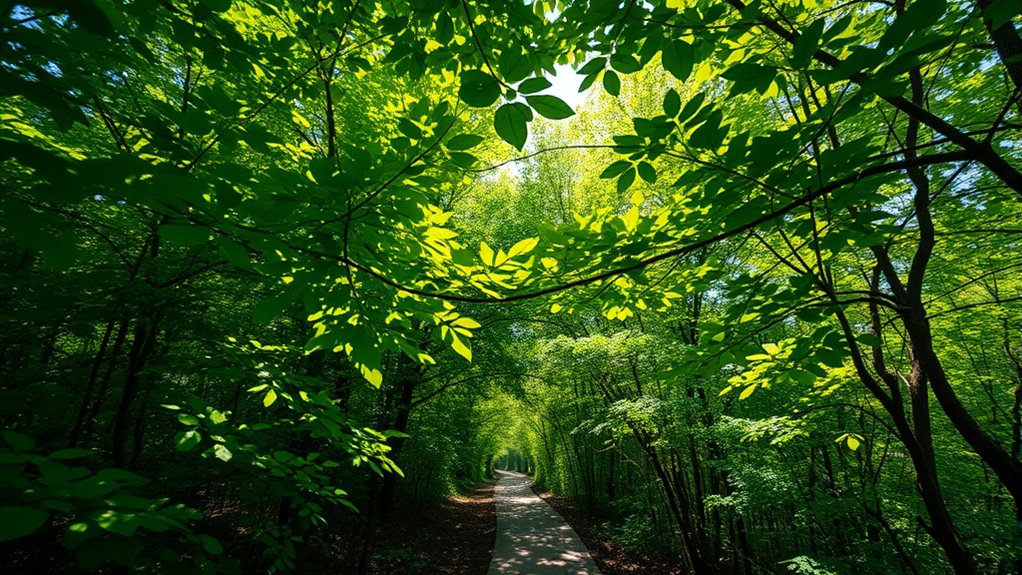A tree-canopy listening walk helps you discover the hidden symphony of wildlife sounds overhead, revealing the vibrant world of birds, insects, and other creatures that thrive above eye level. You’ll slow down, focus on bird calls, insect hums, and the interactions between species, gaining insights into ecosystem health. By noticing these subtle cues, you can deepen your connection to nature. Keep exploring, and you’ll uncover even more stories told through these fascinating sounds.
Key Takeaways
- Tree-canopy listening walks offer immersive experiences to discover diverse bird calls and insect sounds, revealing ecosystem health.
- Guided sound walks can be developed as educational or eco-tourism businesses, promoting wildlife awareness.
- These walks foster deeper connections to nature by enhancing awareness of canopy sounds and wildlife interactions.
- Sound-based experiences can be marketed to schools, nature groups, or eco-travelers seeking unique outdoor activities.
- Incorporating sound recording and analysis services can create additional revenue streams in canopy-based wildlife discovery businesses.

Taking a tree-canopy listening walk invites you to slow down and immerse yourself in the natural sounds overhead. As you step beneath the leafy cover, you become acutely aware of the vibrant symphony happening just above eye level. Bird calls echo through the branches, each species contributing its unique song to the overall chorus. Some calls are sharp and quick, while others are melodious and lingering, revealing the diverse avian community that inhabits the canopy. Listening closely, you’ll notice how bird calls fluctuate with the time of day, weather, and even the seasons. These sounds aren’t just random; they serve purposes like marking territory, attracting mates, or alerting others to danger. By tuning into these vocal cues, you gain insight into the complex social lives of the birds and the health of the ecosystem.
Alongside the bird calls, insect activity adds another layer of sound to the canopy’s orchestra. You might hear the constant hum of cicadas, their rhythmic buzzing punctuating the air. Dragonflies and beetles skitter across leaves, their movements sometimes accompanied by faint rustling sounds. During certain times of year, the chorus of crickets and katydids rises, creating a background drone that blends seamlessly with the bird songs. These insect sounds are crucial indicators of the habitat’s vitality; their presence and behavior reflect the quality of the environment. When insect activity is high, it often signals a thriving ecosystem, while a decline might suggest ecological imbalance. Additionally, the variation in sound quality can be influenced by factors such as sound fidelity, which is affected by the surrounding environment and the presence of natural or artificial barriers.
As you walk, pay attention to how these sounds change and interact. You’ll notice that bird calls often respond to each other, creating call-and-response patterns that can resemble a conversation. Insect activity tends to peak at specific times, especially during warm mornings or late afternoons, revealing the daily rhythm of the canopy’s inhabitants. Your awareness of these subtle auditory cues deepens your connection to the natural world, making the walk more than just a stroll—it’s an opportunity to listen to the hidden wildlife stories unfolding overhead.
Frequently Asked Questions
How Can I Identify Specific Wildlife Sounds During the Walk?
During your walk, focus on sound recognition to identify specific wildlife sounds. Pay attention to pitch, rhythm, and pattern, then compare them to known calls or noises. Using a field guide or app can help with species identification, enhancing your ability to distinguish different animals. Practice regularly, and over time, you’ll become more skilled at recognizing individual species by their unique sounds, making your wildlife listening experience more rewarding.
What Equipment Is Recommended for Optimal Listening Experiences?
For ideal listening during your walk, you should use quality recording devices with good microphones. Focus on sound calibration to guarantee clarity and accuracy of wildlife sounds. A portable digital recorder with adjustable gain settings helps capture subtle sounds, while noise reduction features improve clarity. Always test your equipment beforehand, and consider using headphones for real-time listening. This setup helps you identify specific wildlife sounds more effectively and enhances your overall experience.
Are Guided Tours Available for Beginner Bird and Animal Sound Enthusiasts?
Yes, guided tours are available for beginner birdwatching and sound enthusiasts. These tours provide expert guidance, helping you learn how to identify bird and animal sounds effectively. They’re perfect if you’re just starting out, offering a supportive environment to develop your listening skills. By joining a guided tour, you’ll gain confidence, discover new species, and enjoy the experience of connecting with nature through sound, even as a beginner.
How Does Urban Noise Affect Wildlife Sound Recordings?
You might notice that urban noise often overlaps with wildlife sounds, creating a surprising coincidence. This urban noise causes sound masking, making it harder to capture clear recordings of animals. When you record in busy city environments, the constant background noise can drown out the subtle calls of wildlife. As a result, your recordings may miss important sounds, emphasizing how essential quieter, natural settings are for accurate wildlife sound documentation.
Can Listening Walks Help in Wildlife Conservation Efforts?
Listening walks can definitely support wildlife conservation efforts. By paying attention to urban noise and sound pollution, you become more aware of how these factors impact local wildlife. As you notice the sounds that are missing or altered, you can advocate for quieter, more natural habitats. Your observations help identify areas needing protection or restoration, making your listening walks a valuable tool for conserving wildlife amid urban environments.
Conclusion
As you step into the canopy, listen closely to the symphony of hidden wildlife sounds. Feel the thrill of discovery, the connection to nature, and the wonder of unseen life. Embrace the quiet moments, the vibrant calls, and the delicate whispers of the forest. Let each walk deepen your awareness, sharpen your senses, and ignite your curiosity. With every step, you uncover stories, reveal secrets, and experience the magic of the canopy’s hidden world.










